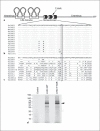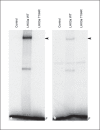A recessive mutation resulting in a disabling amino acid substitution (T194R) in the LHX3 homeodomain causes combined pituitary hormone deficiency
- PMID: 22286346
- PMCID: PMC3355643
- DOI: 10.1159/000335929
A recessive mutation resulting in a disabling amino acid substitution (T194R) in the LHX3 homeodomain causes combined pituitary hormone deficiency
Abstract
Background/aims: Recessive mutations in the LHX3 homeodomain transcription factor gene are associated with developmental disorders affecting the pituitary and nervous system. We describe pediatric patients with combined pituitary hormone deficiency (CPHD) who harbor a novel mutation in LHX3.
Methods: Two female siblings from related parents were examined. Both patients had neonatal complications. The index patient had CPHD featuring deficiencies of GH, LH, FSH, PRL, and TSH, with later onset of ACTH deficiency. She also had a hypoplastic anterior pituitary, respiratory distress, hearing impairment, and limited neck rotation. The LHX3 gene was sequenced and the biochemical properties of the predicted altered proteins were characterized.
Results: A novel homozygous mutation predicted to change amino acid 194 from threonine to arginine (T194R) was detected in both patients. This amino acid is conserved in the DNA-binding homeodomain. Computer modeling predicted that the T194R change would alter the homeodomain structure. The T194R protein did not bind tested LHX3 DNA recognition sites and did not activate the α-glycoprotein and PRL target genes.
Conclusion: The T194R mutation affects a critical residue in the LHX3 protein. This study extends our understanding of the phenotypic features, molecular mechanism, and developmental course associated with mutations in the LHX3 gene.
Copyright © 2012 S. Karger AG, Basel.
Figures





Similar articles
-
Two novel LHX3 mutations in patients with combined pituitary hormone deficiency including cervical rigidity and sensorineural hearing loss.BMC Endocr Disord. 2017 Mar 16;17(1):17. doi: 10.1186/s12902-017-0164-8. BMC Endocr Disord. 2017. PMID: 28302169 Free PMC article.
-
Four novel mutations of the LHX3 gene cause combined pituitary hormone deficiencies with or without limited neck rotation.J Clin Endocrinol Metab. 2007 May;92(5):1909-19. doi: 10.1210/jc.2006-2177. Epub 2007 Feb 27. J Clin Endocrinol Metab. 2007. PMID: 17327381
-
A novel mutation of LHX3 is associated with combined pituitary hormone deficiency including ACTH deficiency, sensorineural hearing loss, and short neck-a case report and review of the literature.Eur J Pediatr. 2011 Aug;170(8):1017-21. doi: 10.1007/s00431-011-1393-x. Epub 2011 Jan 20. Eur J Pediatr. 2011. PMID: 21249393 Review.
-
Molecular analysis of LHX3 and PROP-1 in pituitary hormone deficiency patients with posterior pituitary ectopia.J Clin Endocrinol Metab. 2000 Aug;85(8):2701-8. doi: 10.1210/jcem.85.8.6706. J Clin Endocrinol Metab. 2000. PMID: 10946868
-
Hypopituitarism oddities: congenital causes.Horm Res. 2007;68 Suppl 5:138-44. doi: 10.1159/000110610. Epub 2007 Dec 10. Horm Res. 2007. PMID: 18174732 Review.
Cited by
-
The role of DNA methylation in regulation of the murine Lhx3 gene.Gene. 2014 Jan 25;534(2):272-81. doi: 10.1016/j.gene.2013.10.045. Epub 2013 Oct 31. Gene. 2014. PMID: 24183897 Free PMC article.
-
Dwarfism in Tibetan Terrier dogs with an LHX3 mutation.J Vet Diagn Invest. 2021 Jul;33(4):740-743. doi: 10.1177/10406387211007526. Epub 2021 Apr 23. J Vet Diagn Invest. 2021. PMID: 33890524 Free PMC article.
-
Two novel LHX3 mutations in patients with combined pituitary hormone deficiency including cervical rigidity and sensorineural hearing loss.BMC Endocr Disord. 2017 Mar 16;17(1):17. doi: 10.1186/s12902-017-0164-8. BMC Endocr Disord. 2017. PMID: 28302169 Free PMC article.
-
Hearing impairment and vestibular function in patients with a pathogenic splice variant in the LHX3 gene.BMC Med Genomics. 2024 Nov 15;17(1):270. doi: 10.1186/s12920-024-02049-5. BMC Med Genomics. 2024. PMID: 39548529 Free PMC article.
-
Atlanto-axial malformation and instability in dogs with pituitary dwarfism due to an LHX3 mutation.J Vet Intern Med. 2015 Jan;29(1):207-13. doi: 10.1111/jvim.12523. Epub 2015 Jan 14. J Vet Intern Med. 2015. PMID: 25586673 Free PMC article.
References
-
- Kelberman D, Dattani MT. Role of transcription factors in midline central nervous system and pituitary defects. Endocr Dev. 2009;14:67–82. - PubMed
-
- Pfäffle R, Klammt J. Pituitary transcription factors in the aetiology of combined pituitary hormone deficiency. Best Pract Res Clin Endocrinol Metab. 2011;25:43–60. - PubMed
-
- Prince KL, Walvoord EC, Rhodes SJ. The role of homeodomain transcription factors in heritable pituitary disease. Nat Rev Endocrinol. 2011;7:727–737. - PubMed

